Brest, France
Brest (French pronunciation: [bʁɛst] (![]()
Brest | |
|---|---|
Subprefecture and commune | |
A view of the Tour Tanguy with the Château de Brest in the background | |
 Flag .svg.png) Coat of arms | |
Location of Brest 
| |
 Brest  Brest | |
| Coordinates: 48°23′N 4°29′W | |
| Country | France |
| Region | Brittany |
| Department | Finistère |
| Arrondissement | Brest |
| Canton | Brest-1, 2, 3, 4 and 5 |
| Intercommunality | Brest Métropole |
| Government | |
| • Mayor (2014–2020) | François Cuillandre (PS) |
| Area 1 | 49.51 km2 (19.12 sq mi) |
| Population (2017-01-01)[1] | 140,064 |
| • Density | 2,800/km2 (7,300/sq mi) |
| Time zone | UTC+01:00 (CET) |
| • Summer (DST) | UTC+02:00 (CEST) |
| INSEE/Postal code | 29019 /29200 |
| Elevation | 0–103 m (0–338 ft) (avg. 34 m or 112 ft) |
| Website | brest |
| 1 French Land Register data, which excludes lakes, ponds, glaciers > 1 km2 (0.386 sq mi or 247 acres) and river estuaries. | |
During the Middle Ages, the history of Brest was the history of its castle. Then Richelieu made it a military harbour in 1631.[6] Brest grew around its arsenal until the second part of the 20th century. Heavily damaged by the Allies' bombing raids during World War II, the city centre was completely rebuilt after the war.[7] At the end of the 20th century and the beginning of the 21st century, the deindustrialization of the city was followed by the development of the service sector. Nowadays, Brest is an important university town with 23,000 students.[8] Besides a multidisciplinary university, the University of Western Brittany, Brest and its surrounding area possess several prestigious French elite schools such as École Navale (the French Naval Academy), Télécom Bretagne and the Superior National School of Advanced Techniques of Brittany (ENSTA Bretagne, formerly ENSIETA). Brest is also an important research centre, mainly focused on the sea, with among others the largest Ifremer (French Research Institute for Exploitation of the Sea) centre, le Cedre (Centre of Documentation, Research and Experimentation on Accidental Water Pollution) and the French Polar Institute.
Brest's history has always been linked to the sea: the Académie de Marine (Naval Academy) was founded in 1752 in this city. The aircraft carrier Charles de Gaulle was built there. Every four years, Brest hosts the international festival of the sea, boats and sailors: it is a meeting of old riggings from around the world (Les Tonnerres de Brest).
History
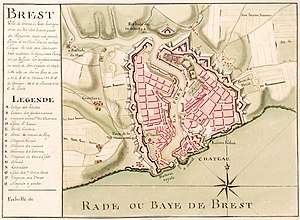
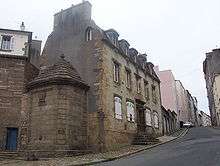
The name of the town is first recorded as Bresta; it may derive from *brigs, a Celtic word for "hill."[9][7]
Nothing definite is known of Brest before about 1240 , when Harvey V, Lord of Léon ceded it to John I, Duke of Brittany. In 1342 John IV, Duke of Brittany surrendered Brest to the English, in whose possession it was to remain until 1397.[6] The importance of Brest in medieval times was great enough to give rise to the saying, "He is not the Duke of Brittany who is not the Lord of Brest." With the marriage of Francis I of France to Claude, the daughter of Anne of Brittany, the definitive overlordship of Brest – together with the rest of the duchy – passed to the French crown in 1491.[6]
The advantages of Brest's situation as a seaport town were first recognized by Cardinal Richelieu, who in 1631 constructed a harbour with wooden wharves. This soon became a base for the French Navy. Jean-Baptiste Colbert, finance minister under Louis XIV, rebuilt the wharves in masonry and otherwise improved the harbour. Fortifications by Vauban (1633–1707) followed in 1680–1688. These fortifications, and with them the naval importance of the town, were to continue to develop throughout the 18th century.
In 1694, an English squadron under Lord Berkeley was soundly defeated in its attack on Brest.
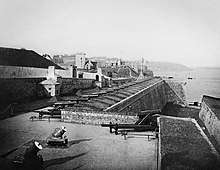
In 1917, during the First World War, Brest was used as the disembarking port for many of the troops coming from the United States. Thousands of such men came through the port on their way to the front lines. The United States Navy established a naval air station on 13 February 1918 to operate seaplanes. The base closed shortly after the Armistice of 11 November 1918.[10]
In the Second World War, the Germans maintained a large U-boat submarine base at Brest. Despite being within range of RAF bombers, it was also a base for some of the German surface fleet, giving repair facilities and direct access to the Atlantic Ocean. For much of 1941, Scharnhorst, Gneisenau and Prinz Eugen were under repair in the dockyards. The repair yard facilities for both submarines and surface vessels were staffed by both German and French workers, with the latter forming the major part of the workforce; huge reliance was made on this French component.[lower-alpha 1][11] In 1944, after the Allied invasion of Normandy, the city was almost totally destroyed during the Battle for Brest, with only a tiny number of buildings left standing. After the war, the West German government paid several billion Deutschmarks in reparations to the homeless and destitute civilians of Brest in compensation for the destruction of their city. Large parts of today's rebuilt city consist of utilitarian granite and concrete buildings. The French naval base now houses the Brest Naval Training Centre. A wartime German navy memorandum suggested that the town should perhaps serve as a German enclave after the war.[12]
In 1972, the French Navy opened its nuclear weapon-submarine (deterrence) base at Île Longue in the Rade de Brest (Brest roadstead). This continues to be an important base for the French nuclear-armed ballistic missile submarines.
Coat of arms
The meaning of the coat of arms of Brest is half France (the three fleurs-de-lis of the former kingdom of France), half Brittany (semé d'hermine of Brittany). These arms were used for the first time in a register of deliberations of the city council dated the 15 July 1683.[13]
Sights
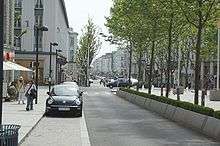
Pont de Recouvrance (Recouvrance Bridge, is a massive drawbridge 64 m/210 ft high), the military arsenal and the rue de Siam (Siam Street) are other sights. The castle and the Tanguy tower are the oldest monuments of Brest.
The Musée de la Tour Tanguy, in the Tanguy tower, houses a collection of dioramas that depict the city of Brest on the eve of World War II. The Musée national de la Marine de Brest, housed in the ancient castle, contains exhibits which outline Brest's maritime tradition, as well as an aquarium, the Océanopolis marine centre. The city also has a notable botanical garden specializing in endangered species, the Conservatoire botanique national de Brest, as well as the Jardin botanique de l'Hôpital d'Instruction des Armées Clermont-Tonnerre.
The city of Brest does not have much remaining historical architecture, apart from a few select monuments such as the castle and the Tanguy tower. This is due to heavy bombing by the Allies during World War II, in an attempt to destroy the submarine base the Germans had built in the harbour. In the 1950s, the town was hastily rebuilt using a large amount of concrete. In Recouvrance, the west bank of the town, there remains an authentic street of the 17th century, Saint-Malo Street.
A few kilometres out of town, there are landscapes, from sandy beaches to grottos to tall granite cliffs. Sunbathing, windsurfing, yachting and fishing are enjoyed in the area. Brest was an important warship-producing port during the Napoleonic wars. The naval port, which is in great part excavated in the rock, extends along both banks of the Penfeld river.
 The Tanguy tower hosts a museum of the history of Brest; in the background, the Pont de Recouvrance (Recouvrance Bridge).
The Tanguy tower hosts a museum of the history of Brest; in the background, the Pont de Recouvrance (Recouvrance Bridge). The castle hosts the Musée national de la Marine (National Navy Museum).
The castle hosts the Musée national de la Marine (National Navy Museum).- the conservatoire botanique national in autumn
 Saint-Sauveur church in Recouvrance, designed by Amédée-François Frézier, the oldest church of Brest, built in 1750[14]
Saint-Sauveur church in Recouvrance, designed by Amédée-François Frézier, the oldest church of Brest, built in 1750[14]- Monumental perspective from the Place de la Liberté opening to the rue de Siam (Siam Street), with the rade de Brest (Brest roadstead) in the background, and on the right, the steeple of Saint-Louis church dominating the rebuilt centre of Brest
Geography

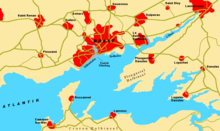
Brest is located amidst a dramatic landscape near the entrance of the natural rade de Brest (Brest roadstead), at the west end of Brittany.
It is situated to the north of a magnificent landlocked bay, and occupies the slopes of two hills divided by the river Penfeld. The part of the town on the left bank is regarded as Brest proper, while the part on the right is known as Recouvrance. There are also extensive suburbs to the east of the town. The hillsides are in some places so steep that the ascent from the lower to the upper town has to be effected by flights of steps and the second or third storey of one house is often on a level with the ground storey of the next.
Climate
Brest experiences an oceanic climate (Köppen: Cfb) in its classic version (due to its location in the Atlantic Ocean and the sea intrusion[15]) where it shares a considerable moderation shared with other places of the Finistère and islands of Great Britain. Its climatic conditions also resemble Neah Bay, Washington but with summers a little warmer and drier in general than this.[16][17]
| Climate data for Brest (Bretagne Airport), elevation: 103 m, 1981–2010 normals, extremes 1855–present | |||||||||||||
|---|---|---|---|---|---|---|---|---|---|---|---|---|---|
| Month | Jan | Feb | Mar | Apr | May | Jun | Jul | Aug | Sep | Oct | Nov | Dec | Year |
| Record high °C (°F) | 16.8 (62.2) |
20.7 (69.3) |
25.0 (77.0) |
28.2 (82.8) |
30.6 (87.1) |
34.3 (93.7) |
35.2 (95.4) |
35.1 (95.2) |
35.0 (95.0) |
28.2 (82.8) |
22.4 (72.3) |
19.0 (66.2) |
35.2 (95.4) |
| Average high °C (°F) | 9.3 (48.7) |
9.5 (49.1) |
11.5 (52.7) |
13.2 (55.8) |
16.2 (61.2) |
18.7 (65.7) |
20.7 (69.3) |
20.8 (69.4) |
19.1 (66.4) |
15.7 (60.3) |
12.2 (54.0) |
9.9 (49.8) |
14.8 (58.6) |
| Daily mean °C (°F) | 6.9 (44.4) |
6.8 (44.2) |
8.4 (47.1) |
9.6 (49.3) |
12.6 (54.7) |
15.0 (59.0) |
16.9 (62.4) |
17.0 (62.6) |
15.4 (59.7) |
12.7 (54.9) |
9.5 (49.1) |
7.3 (45.1) |
11.5 (52.7) |
| Average low °C (°F) | 4.4 (39.9) |
4.1 (39.4) |
5.4 (41.7) |
6.1 (43.0) |
8.9 (48.0) |
11.2 (52.2) |
13.2 (55.8) |
13.2 (55.8) |
11.6 (52.9) |
9.6 (49.3) |
6.7 (44.1) |
4.8 (40.6) |
8.3 (46.9) |
| Record low °C (°F) | −14.0 (6.8) |
−13.4 (7.9) |
−4.9 (23.2) |
−3.0 (26.6) |
−0.2 (31.6) |
3.8 (38.8) |
6.0 (42.8) |
6.0 (42.8) |
3.3 (37.9) |
−1.5 (29.3) |
−6.6 (20.1) |
−10.1 (13.8) |
−14.0 (6.8) |
| Average precipitation mm (inches) | 143.8 (5.66) |
111.7 (4.40) |
95.8 (3.77) |
92.1 (3.63) |
79.0 (3.11) |
59.8 (2.35) |
66.8 (2.63) |
66.8 (2.63) |
83.3 (3.28) |
129.0 (5.08) |
134.1 (5.28) |
147.8 (5.82) |
1,210 (47.64) |
| Average precipitation days (≥ 1.0 mm) | 17.7 | 14.0 | 14.5 | 13.0 | 11.3 | 8.6 | 10.4 | 9.6 | 10.1 | 15.7 | 16.9 | 17.2 | 159.0 |
| Average snowy days | 1.7 | 2.8 | 0.7 | 0.3 | 0.0 | 0.0 | 0.0 | 0.0 | 0.0 | 0.0 | 0.5 | 1.3 | 7.3 |
| Mean monthly sunshine hours | 61.4 | 77.4 | 118.7 | 156.3 | 179.8 | 190.6 | 169.4 | 172.9 | 160.2 | 107.7 | 70.7 | 64.8 | 1,529.8 |
| Source: Meteo France[18][19][20] | |||||||||||||
| Climate data for Brest (Bretagne Airport), elevation: 103 m, 1961–1990 normals and extremes | |||||||||||||
|---|---|---|---|---|---|---|---|---|---|---|---|---|---|
| Month | Jan | Feb | Mar | Apr | May | Jun | Jul | Aug | Sep | Oct | Nov | Dec | Year |
| Record high °C (°F) | 16.5 (61.7) |
18.3 (64.9) |
22.6 (72.7) |
26.7 (80.1) |
28.6 (83.5) |
33.3 (91.9) |
32.2 (90.0) |
34.8 (94.6) |
32.6 (90.7) |
24.1 (75.4) |
20.7 (69.3) |
18.3 (64.9) |
34.8 (94.6) |
| Mean maximum °C (°F) | 11.0 (51.8) |
12.5 (54.5) |
13.1 (55.6) |
16.0 (60.8) |
20.6 (69.1) |
23.1 (73.6) |
24.7 (76.5) |
23.3 (73.9) |
21.0 (69.8) |
18.3 (64.9) |
13.3 (55.9) |
11.5 (52.7) |
24.7 (76.5) |
| Average high °C (°F) | 9.3 (48.7) |
9.0 (48.2) |
10.6 (51.1) |
12.3 (54.1) |
14.9 (58.8) |
17.9 (64.2) |
19.7 (67.5) |
19.7 (67.5) |
18.3 (64.9) |
15.4 (59.7) |
11.5 (52.7) |
9.7 (49.5) |
14.0 (57.2) |
| Daily mean °C (°F) | 7.0 (44.6) |
6.5 (43.7) |
7.4 (45.3) |
8.8 (47.8) |
11.6 (52.9) |
14.2 (57.6) |
16.2 (61.2) |
16.2 (61.2) |
15.1 (59.2) |
12.4 (54.3) |
8.9 (48.0) |
7.4 (45.3) |
11.0 (51.8) |
| Average low °C (°F) | 4.6 (40.3) |
4.0 (39.2) |
4.5 (40.1) |
5.5 (41.9) |
8.0 (46.4) |
10.6 (51.1) |
12.3 (54.1) |
12.6 (54.7) |
11.8 (53.2) |
9.4 (48.9) |
6.2 (43.2) |
4.8 (40.6) |
7.9 (46.1) |
| Mean minimum °C (°F) | −2.0 (28.4) |
−0.7 (30.7) |
1.8 (35.2) |
3.4 (38.1) |
6.5 (43.7) |
8.7 (47.7) |
11.4 (52.5) |
11.1 (52.0) |
9.0 (48.2) |
6.6 (43.9) |
4.3 (39.7) |
1.9 (35.4) |
−2.0 (28.4) |
| Record low °C (°F) | −10.9 (12.4) |
−9.2 (15.4) |
−4.9 (23.2) |
−2.3 (27.9) |
0.0 (32.0) |
3.8 (38.8) |
6.0 (42.8) |
6.8 (44.2) |
3.5 (38.3) |
0.2 (32.4) |
−6.6 (20.1) |
−10.1 (13.8) |
−10.9 (12.4) |
| Average precipitation mm (inches) | 136.4 (5.37) |
90.0 (3.54) |
104.4 (4.11) |
71.5 (2.81) |
72.7 (2.86) |
51.5 (2.03) |
41.2 (1.62) |
61.0 (2.40) |
69.1 (2.72) |
94.1 (3.70) |
111.7 (4.40) |
132.0 (5.20) |
1,035.6 (40.76) |
| Average precipitation days (≥ 1.0 mm) | 18.0 | 13.5 | 15.5 | 13.0 | 11.0 | 8.5 | 8.0 | 8.5 | 10.0 | 12.5 | 17.0 | 17.0 | 152.5 |
| Average snowy days | 2.0 | 2.5 | 1.6 | 0.5 | 0.1 | 0.0 | 0.0 | 0.0 | 0.0 | 0.0 | 0.5 | 1.2 | 8.4 |
| Average relative humidity (%) | 86 | 84 | 82 | 81 | 81 | 83 | 83 | 83 | 85 | 86 | 85 | 86 | 84 |
| Mean monthly sunshine hours | 63.6 | 87.9 | 126.5 | 174.9 | 211.9 | 216.1 | 229.3 | 206.2 | 168.0 | 123.6 | 80.4 | 63.3 | 1,751.7 |
| Percent possible sunshine | 24.0 | 31.0 | 35.0 | 43.0 | 46.0 | 46.0 | 48.0 | 47.0 | 45.0 | 37.0 | 29.0 | 25.0 | 38.0 |
| Source 1: NOAA[21] | |||||||||||||
| Source 2: Infoclimat.fr (humidity)[22] | |||||||||||||
Transport
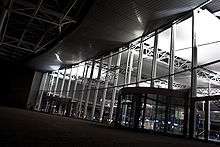

The railway station of Brest, Gare de Brest, is linked to Rennes and Paris and provides services to other stations in Brittany as well. TGV trains to Paris take approximately three hours and forty minutes to reach the capital.
A new 28 stop, 14.3 km (9 mi) tram line connecting Porte de Plouzané in the west with Porte de Gouesnou and Porte de Guipavas northeast of the city centre opened in June 2012.[23]
Brest international airport, Brest Bretagne Airport, is mainly linked to Paris, London, Nice, Lyon, Dublin. The primarily operator is Air France (via its subsidiary HOP!). Brest international airport is the main airport of the region of Brittany in terms passager traffic with 45% of this traffic of the region, representing 919,404 passengers in 2010.[24] A new terminal has been in service since 12 December 2007 and can accommodate up to 1.8 million passengers annually.[25]
The harbour of Brest is mainly dedicated to bulk, hydrocarbon and freight containers. The harbour's facilities can accommodate the largest modern ships. A cruise ship port is also located in Brest, near the city centre.[26]
Economy

Due to its location, Brest is regarded as the first French port that can be accessed from the Americas. Shipping is big business, although Nantes and Saint-Nazaire offer much larger docks and attract more of the larger vessels. Brest has the ninth French commercial harbour including ship repairs and maintenance. The protected location of Brest means that its harbour is ideal to receive any type of ship, from the smallest dinghy to the biggest aircraft carrier (USS Nimitz has visited a few times). Naval construction is also an important activity: for example, the French aircraft carrier Charles de Gaulle was built by Direction des Constructions Navales (DCN) in Brest.
Despite its image of an industrialised city whose activity depends mainly on military order, the service sector represents 75% of the economic activity. The importance of the service sector is still increasing while industrialised activity is decaying, explaining the unchanged rate of working-class in Brest. Brest also hosts headquarters for many subsidiaries like the banking group Arkéa. Research and conception is taking an increasing importance. Brest claims to be the largest European centre for sciences and techniques linked to the sea: 60% of the French research in the maritime field is based in Brest.[27]
Administration
- since 2001: François Cuillandre
- 1989 –2001: Pierre Maille (2nd and 3rd terms)
- 1985–1989: Georges Kerbrat
- 1983–1985: Jacques Berthelot
- 1982–1983: Pierre Maille
- 1977–1982: Francis Le Blé
- 1973–1977: Eugène Berest
- 1959–1973: Georges Lombard
- 1958–1959: Auguste Kervern
- 1954–1958: Yves Jaouen
- 1954–1954: Lucien Chaix
- 1953–1954: Yves Jaouen
- 1947–1953: Alfred Pierre Marie Chupin
- 1945–1947: Jules Lullien
- 1944–1945: Jules Lullien
- 1942–1944: Victor Eusen
- 1929–1941: Victor Le Gorgeu
- 1921–1929: Léon Nardon
- 1920–1921: Hippolyte Masson
- 1919–1920: Louis Léon Nardon
- 1912–1919: Hippolyte Masson
- 1908–1912: Louis Arthur Delobeau
- 1904–1908: Victor Marie Aubert
- 1900–1904: Charles Berger
Breton language
Breton is not commonly spoken in the city of Brest, which was the only French-speaking city in western Brittany before the 1789 French Revolution, despite the surrounding countryside being fully Breton-speaking at that time. Like other French minority languages, Breton does not have any official language status in France.
The municipality launched a linguistic plan to revive Breton as a language through Ya d'ar brezhoneg on 16 June 2006. In 2008, 1.94% of primary-school children attended French-Breton bilingual Diwan schools.[28] Besides bilingual schools, the Breton language is also taught in some schools and universities.
The association Sked federates all Breton cultural activities.[29]
Culture
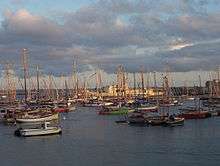
The city is host to several events to celebrate its long maritime history. The largest of these is held every four years, when the town organises a tall ship meeting. The last such tall ship event was "Les Tonnerres de Brest 2012" .
Brest also hosts an annual short film festival called "Brest European Short Film Festival". The city was the setting for the 1982 art film Querelle, directed by Rainer Werner Fassbinder.
Cuisine
Brittany's most famous local delicacy, the Breton crêpe, is the main culinary feature apart from seafood. There are many crêpe restaurants (called crêperies). Breton apple cider is often featured.
Traditional biscuits include Traou Mad, which is a full-fat butter biscuit similar to Scottish shortbread.
Sport
Since 1901 Brest has served as the midpoint for the 1,200 km (750 mi) bicycle endurance event, Paris–Brest–Paris. Brest is home to Stade Brestois 29, a football team in Ligue 1.
In 2002 the Brest throwball team Brest LC reached the 1st division of French throwball but were subsequently relegated due to financial difficulty. The club has recently adopted an Irish influenced infrastructure.
The 2008 Tour de France started in Brest. Stage 6 of the 2018 Tour de France will depart in Brest.
Brest is also home to Les Albatros, an ice hockey team in Ligue Magnus, and 2 league titles in the 90's.
Research and education

Primarily the research centre of western Brittany, Brest and its surrounding area is the home of several research and elite educational establishments:
- a multidisciplinary university, Université de Bretagne Occidentale (UBO)
- Brest has also several grandes écoles and other undergraduate or graduate schools:
- École nationale d'ingénieurs de Brest (ENIB) (in Plouzané next to Brest)
- Télécom Bretagne (ENST Bretagne) (in Plouzané next to Brest)
- École nationale supérieure de techniques avancées de Bretagne (ENSTA Bretagne, formerly ENSIETA)
- Institut supérieur de l'électronique et du numérique de Brest (ISEN Brest)
- Brest Business School (ESC Bretagne Brest)
- École Navale (French Naval Academy) (in Lanvéoc next to Brest)
- To be noted that Brest is one of the hosts for the Indiana University Honors Foreign Language Program
- Brest has several research organisations:
- the largest Ifremer (French Research Institute for Exploitation of the Sea) centre (in Plouzané next to Brest); about 1000 people work there.[30]
- Le Cedre (Centre of Documentation, Research and Experimentation on Accidental Water Pollution)[31]
- the French Polar Institute (in Plouzané next to Brest)
- The Naval Hydrographic and Oceanographic Service (SHOM)
Notable people
Brest was the birthplace of:
- Jean-Michel Huon de Kermadec (1748–1792), navigator
- Charles-Alexandre Léon Durand Linois (1761–1848), admiral during the time of Napoleon Bonaparte
- Prosper Garnot (1794–1838), surgeon and naturalist
- Léon Moreau (1870–1946), composer
- Victor Segalen (1878–1919), naval doctor, ethnographer, archeologist, writer and poet
- Jean Cras (1879–1932), French composer and career naval officer
- Georges Thierry d'Argenlieu (1889–1964), priest, diplomat and French Navy officer and admiral
- Jean Loysel (1889–1962), composer and lyricist
- Alain Robbe-Grillet (1922–2008), writer and filmmaker
- Pierre Brice (1929–2015), actor
- Béatrice Dalle (born 1964), actress
- Christophe Miossec (born 1964), singer
- Yann Tiersen (born 1970), minimalist multi instrumentalist/musician
- Sébastien Flute (born 1972), Olympic gold medalist
- Benoît Menut (born 1977), composer
- Larsen Touré (born 1984), footballer (naturalized Guinean)
- Gonzalo Higuaín (born 1987), footballer (naturalized Argentine)
- Laury Thilleman (born 1991), Miss France 2011
- Benoît Hamon (born 1967), MEP and French presidential candidate, Parti Socialiste, 2017
International relations

Friendly relationship
Brest has an official friendly relationship (protocole d'amitié) with:[32]

See also
Notes
- For example, by Feb 1941 only 470 German shipyard workers had arrived at Brest, whilst the Naval Arsenal had 6,349 French workers. Though work on capital ships was generally done by Germans, French employees worked extensively on submarines and the smaller military vessels in the surface fleet. German Navy reports indicate that this was a willing workforce and that there were no incidences of sabotage. As well as working on ship repairs, the French provided a significant fire-fighting force to help negate the effect of Allied air raids. This story is balanced by Resistance activity, such as that of Jean Philippon, a French Naval Lieutenant Commander who provided important ship movement intelligence to the Allies for more than a year. This espionage was a key component in the effectiveness of Allied air raids which ultimately led to the removal of German capital ships to safer bases.
References
- "Populations légales 2017". INSEE. Retrieved 6 January 2020.
- Wells, John C. (2008), Longman Pronunciation Dictionary (3rd ed.), Longman, ISBN 9781405881180
- Nouvel atlas linguistique de la Base-Bretagne, 2001, Volume 1, map 6.
- Stina Backer (31 March 2018). "Brest, France: What to see and do". CNN Travel.
- Brest.fr – Brest perspectives Archived 3 July 2011 at the Wayback Machine
- "Brest, France". Encyclopædia Britannica.
- Koch, John T., ed. (2006). Celtic Culture: A Historical Encyclopedia. 1. Santa Barbara, California: ABC-CLIO. p. 247. ISBN 1-85109-440-7.
- Gaële MALGORN (22 February 1999). "Brest accueille ses 23 000 étudiants". Participation Brest. Archived from the original on 18 July 2011. Retrieved 6 April 2011.
- https://www.etymonline.com/word/brest
- Van Wyen, Adrian O. (1969). Naval Aviation in World War I. Washington, D.C.: Chief of Naval Operations. p. 65.
- Hellwinkel, Lars (2014). Hitler's Gateway to the Atlantic: German Naval Bases in France 1940–1945 (Kindle ed.). Seaforth Publishing. pp. Kindle location 1151–1369.
- "The Nizkor Project – Nuremberg Trials transcript". Archived from the original on 26 January 2013. Retrieved 20 December 2012.
- Les Armoiries de Brest.
- Jean-Louis Auffret, Brest d'hier à demain, Éditions Cloître, March 2002, Saint-Thonan France, ISBN 2-910981-65-7, page 25
- "Brest Map: Detailed maps for the city of Brest – ViaMichelin". viamichelin.co.uk. Retrieved 18 January 2019.
- "Updated Köppen-Geiger climate map of the world". people.eng.unimelb.edu.au. Retrieved 18 January 2019.
- "Neah Bay, Washington Travel Weather Averages (Weatherbase)". Weatherbase. Retrieved 18 January 2019.
- "Données climatiques de la station de Brest" (in French). Meteo France. Retrieved 11 December 2014.
- "Climat Bretagne" (in French). Meteo France. Retrieved 11 December 2014.
- "Brest–Guipavas (29)" (PDF). Fiche Climatologique: Statistiques 1981–2010 et records (in French). Meteo France. Archived from the original (PDF) on 10 March 2018. Retrieved 10 March 2018.
- "Brest (07110) – WMO Weather Station". NOAA. Retrieved 18 January 2019. Archived 18 January 2019, at the Wayback Machine
- "Normes et records 1961–1990: Brest-Guipavas (29) – altitude 94m" (in French). Infoclimat.fr. Archived from the original on 8 October 2014. Retrieved 11 December 2014.CS1 maint: BOT: original-url status unknown (link) 8 October 2014, at the Wayback Machine
- "Brest tramway opens". Railway Gazette International. 26 June 2012. Retrieved 29 June 2012.
- "Le Télégramme – Brest ville – Port et aéroport de Brest. Progressions en 2010". Brest.letelegramme.com. Retrieved 6 April 2011.
- "brest.aeroport.bzh/ » Environment". Airport.cci-brest.fr. 4 August 2005. Archived from the original on 20 July 2011. Retrieved 6 April 2011.
- https://www.avidcruiser.com/port-profiles/europe/mediterranean/france/brest/, Port of Call: Brittany’s Brest
- Source: Invest in Brest, BMO Archived 22 November 2008 at the Wayback Machine
- (in French) Ofis ar Brezhoneg: Enseignement bilingue
- "[SKED] Les nouveautés". Sked.infini.fr. Archived from the original on 28 January 2013. Retrieved 26 March 2013.
- "Institut". Ifremer.fr. Retrieved 6 April 2011.
- "Cedre: Centre of Documentation, Research and Experimentation on Accidental Water Pollution". Cedre.fr. 17 March 2011. Retrieved 6 April 2011.
- Les jumelages de Brest Archived 15 July 2009 at the Wayback Machine
- "Our First Sister City" (PDF). Denver Sister Cities International. Archived from the original (PDF) on 21 November 2015. Retrieved 20 November 2015.
- "British towns twinned with French towns". Archant Community Media Ltd. Archived from the original on 5 July 2013. Retrieved 11 July 2013.
- "Les jumelages". Brest.fr. Archived from the original on 25 May 2011. Retrieved 6 April 2011.
- "Twin towns". Plymouth City Council. Retrieved 1 March 2008.
- General
Bibliography
External links
| Wikimedia Commons has media related to Brest (France). |
| Wikisource has the text of the 1911 Encyclopædia Britannica article Brest. |
- Aerial photos of the whole city and urban community
- Brest Airport Travel Guide
- Interactive City Map of Brest
- Official website of Brest town hall (with webcam)
- Satellite picture by Google Maps
- Brest Cultural Heritage (in French)
- Brest improvisation theatre
- Wiki-Brest, a community wiki containing articles about the city (in French).
- German submarine base in Brest